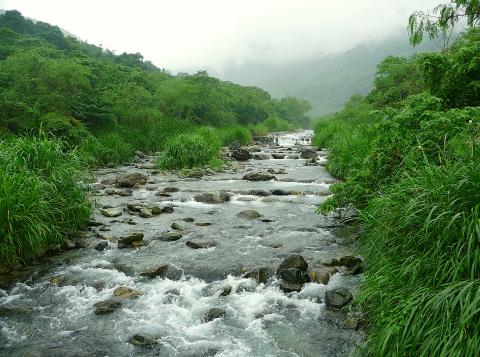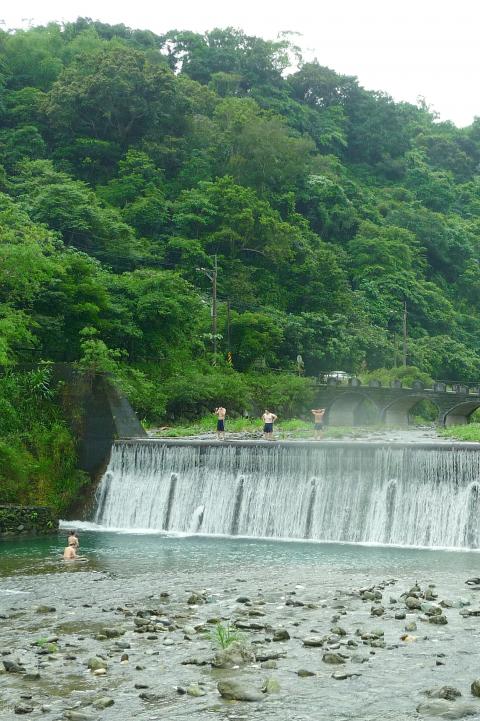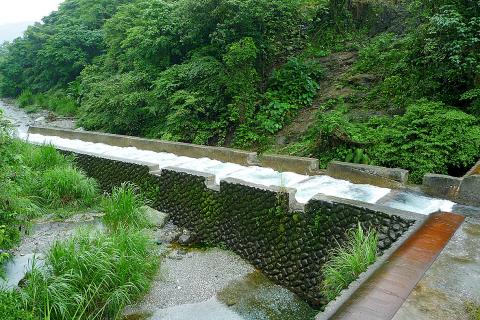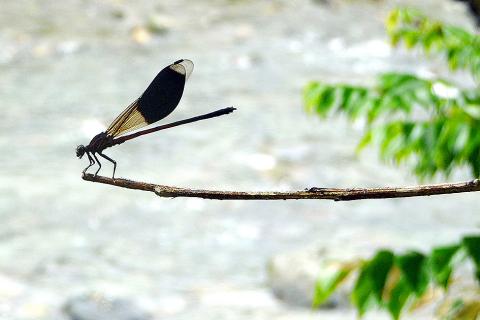Where I come from, people say that if you’re thinking of buying a piece of real estate, you should view it in bad weather. Baibao Creek (白鮑溪) in Hualien County passes that test with ease.
The Chinese-language blogosphere is awash with photos of tourists frolicking in the creek beneath blue skies. However, I’ve been as far up this short valley as it’s possible to ride a motorcycle three times, and on each occasion the weather has been inclement. Despite this, it remains a favorite place of mine, neither crowded nor remote.
While exploring the valley, I’ve never come close to seeing the top of Mukua Mountain (木瓜山). The creek’s source is on the southern slopes of this 2,427-meter-tall mountain.

Photo: Steven Crook
Driving to the creek from Shoufeng Railway Station (壽豐火車站) takes less than 20 minutes, although the bilingual signs aren’t obvious until you get onto Highway 9C (台9丙), the road to Liyu Lake (鯉魚潭). Near the 21.5km marker, a sign will direct you up a side road. There’s a small parking lot at the end of this road, but you’ll likely want to stop once or twice before then to take in the scenery.
Many waterways in western Taiwan are hemmed in by concrete. Baibao Creek — a tributary of the Hualien River — is different. One reason is that the central government’s Forestry Bureau has designated it an outdoor hydrology/ecology classroom. The local climate is another reason: the eastern half of the island has never been as susceptible to flooding as the western lowlands.
In Taiwan’s highlands, many streams are punctuated by weirs built to control sediment washing out of the mountains and into reservoirs. Barriers of this sort make it very difficult for fish to move up and down rivers, and their proliferation is thought to be one of the reasons why the number of Formosan landlocked salmon dwindled after the early 1960s. Of the various eco-engineering techniques which have been applied to Baibao Creek, fish ladders, which allow fish to make their way upstream by leaping and swimming up one shallow step at a time, are the most obvious.

Photo: Steven Crook
Where the creek’s banks have needed stabilizing, the reinforcing materials are stone and lumber. The environment is as pristine as is possible in such an accessible spot; if you’re quiet and observant, you’ll see an impressive range of creatures.
According to ebird.org, a Web site through which birders report what they see, at least 88 avian species have been spotted around the creek. In addition to the usual egrets and crested serpent eagles, the delightfully cute Japanese White-eye and the gloriously colorful Gray-chinned Minivet (much of its body is a rich shade of orange) make frequent appearances.
One of the more unusual amphibian residents is buergeria robustus (褐樹蛙); it doesn’t have an English name because it’s endemic to Taiwan. The Chinese name translates as “brown tree frog.” Among creatures which stay in the water are shrimps, the dark brown candidiopotamon rathbuni crab and the Taiwan shovel-jaw carp (onychostoma barbatulum).

Photo: Steven Crook
JADE INDUSTRY
Baibao Creek is also associated with Taiwan’s jade industry, which flourished millennia ago (some was traded as far away as what’s now Malaysia), and again in the 20th century. Many people know that Taiwan has at times been the world’s top manufacturer of tennis rackets, sewing machines and printed circuit boards. Far fewer are aware that Taiwanese mines produced more than half of the world’s nephrite (one of the two types of jade; the other is jadeite) between 1962 and 1986.
Scouring the creek bed for pieces of nephrite and serpentine is almost as popular a pastime among visitors as splashing in the water. However, I haven’t been able to find out if removing material of this kind is legal or not. If you’re determined to take home this kind of souvenir, visiting one of the local jade workshops is a far better option.

Photo: Steven Crook
Shoufeng Township has two other places that could interest travelers curious about water ecosystems. Fengjhihgu Wetland Park (豐之谷溼地公園) is a few kilometers west of Shoufeng Railway Station. Chinese-speakers may want to sign up for DIY activities like papermaking and handkerchief dyeing. Alternatively, find a quiet spot and watch the ducklings follow their mothers.
Almost next door to Fengjhihgu Wetland Park, Li Chuan Aquafarm (立川漁場) specializes in nurturing a particular type of mollusk. The freshwater Taiwan Clam (corbicula fluminea formosa) is an endemic subspecies of the Asian clam that’s considered a troublesome invasive in parts of the Americas.
The Taiwan Clam was previously so common that a Hoklo-language version of “kill two birds with one stone” is it kiam ji koo, bong la-a kiam se khoo, “gather clams while washing your pants.” In the days of yore, of course, country people did their laundry in the nearest creek.
Nowadays, the Taiwan Clam is seldom found in nature, due to the use of ammonium-based fertilizers and the rebuilding of irrigation ditches with concrete. The almost triangular shell is usually dark brown or even black, but because the water in Shoufeng is so clean, the mollusks cultivated here are yellowish brown and promoted as “golden clams” (黃金蜆). They need seven to eight months to mature. Cold weather can slow their growth — but should never deter humans from visiting this splendid area.
Steven Crook has been writing about travel, culture, and business in Taiwan since 1996. Having recently co-authored A Culinary History of Taipei: Beyond Pork and Ponlai, he is now updating Taiwan: The Bradt Travel Guide.

In the March 9 edition of the Taipei Times a piece by Ninon Godefroy ran with the headine “The quiet, gentle rhythm of Taiwan.” It started with the line “Taiwan is a small, humble place. There is no Eiffel Tower, no pyramids — no singular attraction that draws the world’s attention.” I laughed out loud at that. This was out of no disrespect for the author or the piece, which made some interesting analogies and good points about how both Din Tai Fung’s and Taiwan Semiconductor Manufacturing Co’s (TSMC, 台積電) meticulous attention to detail and quality are not quite up to

April 21 to April 27 Hsieh Er’s (謝娥) political fortunes were rising fast after she got out of jail and joined the Chinese Nationalist Party (KMT) in December 1945. Not only did she hold key positions in various committees, she was elected the only woman on the Taipei City Council and headed to Nanjing in 1946 as the sole Taiwanese female representative to the National Constituent Assembly. With the support of first lady Soong May-ling (宋美齡), she started the Taipei Women’s Association and Taiwan Provincial Women’s Association, where she

Chinese Nationalist Party (KMT) Chairman Eric Chu (朱立倫) hatched a bold plan to charge forward and seize the initiative when he held a protest in front of the Taipei City Prosecutors’ Office. Though risky, because illegal, its success would help tackle at least six problems facing both himself and the KMT. What he did not see coming was Taipei Mayor Chiang Wan-an (將萬安) tripping him up out of the gate. In spite of Chu being the most consequential and successful KMT chairman since the early 2010s — arguably saving the party from financial ruin and restoring its electoral viability —

It is one of the more remarkable facts of Taiwan history that it was never occupied or claimed by any of the numerous kingdoms of southern China — Han or otherwise — that lay just across the water from it. None of their brilliant ministers ever discovered that Taiwan was a “core interest” of the state whose annexation was “inevitable.” As Paul Kua notes in an excellent monograph laying out how the Portuguese gave Taiwan the name “Formosa,” the first Europeans to express an interest in occupying Taiwan were the Spanish. Tonio Andrade in his seminal work, How Taiwan Became Chinese,